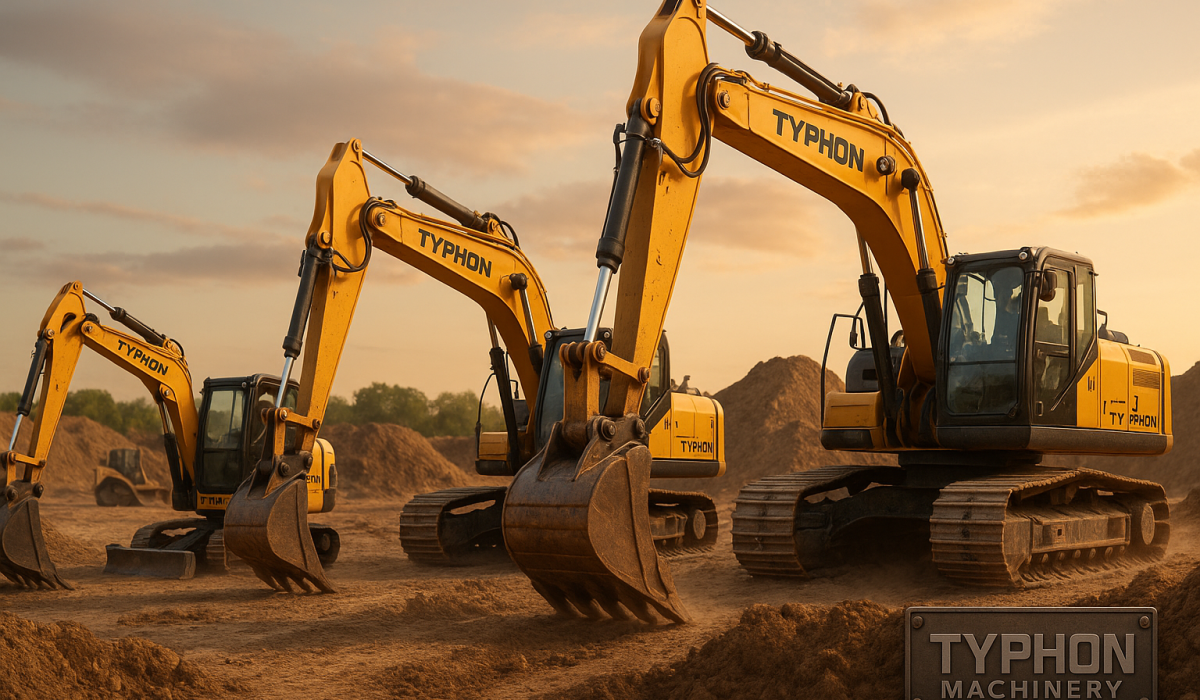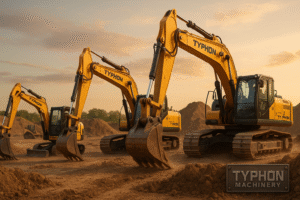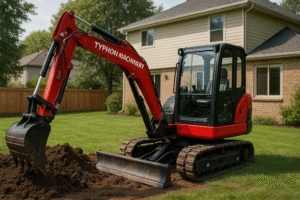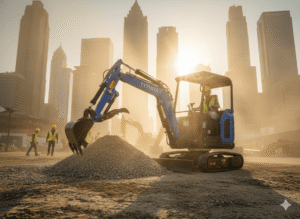How Wrong Excavator Size Can Cost You Time And Money
Choosing the right excavator size for construction, landscaping, and mining projects is very important for increasing work efficiency, safety and reducing costs. A knowledge of how to match the different sizes of an excavator with the specific job requirements can bring you the desired outcome of the task and can save your time and money. This detailed guide is pointing to the different excavator sizes available, their respective uses, and the primary considerations that should be weighed in making your decision.
Today, excavators are divided into several size classes, each employing different applications and working conditions concepts. The choice of the right one ranges from a tiny mini-excavator (less than 7 tons) to a giant heavy-duty machine (over 45 tons) and depends on the project, site, the materials you will be handling and how much money you have to spend.
The experts in the industry state that the right size of the excavator being used directly affects the work performance, the safety of the operator, and the return on investment, and hence, this process is of utmost importance for professionals in construction and contractors of the trade.
In-Depth Understanding on Excavator Size Categories
Mini Excavators (1-7 Tons)
Mini Excavators also called compact excavators, are the smallest among the excavator family and are mostly used for doing precise works in limited spaces. Their weights normally range from 1 to 7 tons, and what they lack in size they make up for in agility, and at the same time, they still have all the functionalities of a large machine.
Mini excavators are capable of delivering from 3,000 to 4,000 pounds of bucket breakout force, therefore, they serve the best in light works where accuracy and accessibility are primary concerns.
The compactness of mini excavators makes it possible for them to work in very tight spaces of about 6 feet by 6 feet, with the tracks being retractable; the width can be reduced to only 3 feet for passing through doorways and narrow openings. Such equipment is perfect for carrying out tasks in residential construction, landscaping activities, utility installation, and minor demolishing.
Their low ground pressure is of a great advantage in that it prevents any damage from happening to the area; thus, such machine is a perfect tool for working near existing buildings or environmentally sensitive locations.
Mini excavators can be effectively used in the following areas:
- Foundation digging for homes and small-scale commercial building
- Digging trenches for utility lines, drainage systems, and irrigation
- Landscaping projects such as building ponds, preparing garden beds, and planting trees
- Indoor demolition and renovation works that can be accessed through standard doorways
Standard Excavators (10-45 Tons)
Standard excavators that weigh in the range from 10 to 45 tons are the most diverse and versatile machines of the construction industry. Being the perfect balance of the three main features i.e., power, mobility and, operational effectiveness, these machines stand a good chance to be the most widely used ones in commercial construction projects.
The bucket breakout force of standard excavators is in the range of 20,000 to 60,000 pounds thus, giving such a machine the ability to effectively perform heavy-duty excavation, material handling, and demolition tasks.
Standard excavators are known for their versatility which makes them the main instrument used in most construction activities, road works, site preparation, and demolition projects ranging from medium to large scale.
The machines can be equipped with a wide range of hydraulic attachment options such as different sizes of buckets, hydraulic hammers, grapples, and the other specialized tools which as a result will greatly expand their working capabilities.
Moreover, their size emits them perfect for transport on regular trailers but, at the same time, they remain powerful enough for most of the commercial applications.
Examples of standard excavators applications are:
- Commercial construction site preparation and foundation works
- Road construction, as well as the digging of foundations for roadbeds and drainage systems
- Medium-sized structures demolition and material handling operations
- Mining operations necessitating substantial digging force and material movement capacities
Large Excavators (45+ Tons)
Large excavators (more than 45 tons) are generally heavy-duty machines designed to handle industrial projects, large-scale constructions, and mining operations. The can be very powerful to generate a tremendous breakout force and handle a very high volume of material, thus, becoming very useful in projects that require a lot of earthmoving work.
However, their transport and operating aspect are not so convenient due to their size that there should be a thoughtful consideration during the planning phase of the project.
Great power and capacity are the features that make large excavators indispensable for major infrastructure projects, open-pit mining, large-scale demolition, and deep excavation. The cost of their transportation is much higher than that of common machines because they may call for special permits and also partial disassembling of the machine in order to be transported from one site to the other. Nevertheless, the huge volume of material that they can shift quickly frequently makes up for these logistical issues in cases where they are used correctly.
Large excavators are optimal for:
- Major infrastructure projects such as highway construction and large commercial developments
- Mining operations that involve the need for deep excavation and high-volume material handling
- Demolition on large industrial facilities and multi-story buildings
- Deep foundation work for major commercial and industrial structures
Critical Factors for Excavator Size Selection
1. Worksite Accessibility and Space Constraints
What is maybe the most important factor in deciding the size of the excavator is the accessibility of the work site. The very site dimensions will directly determine the degree to which the equipment can be maneuvered and the overall operational efficiency.
Building projects in the city, housing developments, and renovation works are examples of tightly-spaced locations where smaller-sized machines are preferred, while in open areas with a lot of space bigger machines can be used more efficiently.
Also, it is necessary to check the access roads to the site, which may be bridges, roads, or entry points, to be sure that the chosen excavator will be able to get there safely.
The ground where the work is to be done and the stability of the site also determine which excavator will be used as heavier machines exert greater pressure on the ground and may cause damage to the surfaces completed or the soil which is not yet stable.
If there are existing buildings, utilities, and features of the landscape, it is necessary to take into account the radius of the arm of the excavator and the open area in which it can operate.
Moreover, the requirements for going to and from the site should also be considered during the selection, since a big-sized machine may require special hauling equipment and permits for transportation.
Accessibility considerations at the core are:
- Working space available and swing radius necessary for safe operation
- Access routes to a site and any limitations regarding the equipment size and weight
- Ground conditions and work surface load-bearing capacity
- Distance from existing buildings, utilities, and other obstacles that could hamper the motion
2. Material Type and Excavation Requirements
The matter to be removed and the exact excavation requirements have an immense effect on the need for an excavator of a certain size as well as soil conditions and of course, the demand for the equipment’s strength and capacity vary dramatically.
In fact, rocky terrain, hard clay, and frozen earth need a lot of power as compared to loose soil or sand and hence, large hydraulic machines have to be utilized. Furthermore, the demanded dig depth and extension also dictate the minimal size of the machine as every excavator group has its specific limits in operations.
Project specifications such as trench width, foundation size, and material handling volume should be compatible with the working capabilities of the excavator in order to complete the work efficiently.
The need for accuracy as opposed to production also decides on size, smaller excavators providing more control and accuracy while in bigger machines material movement speed and volume dominate.
First analyzing the project material through a soil test then selecting the proper excavator is the best way of getting the job done efficiently.
Material-related factors include:
- Soil composition, density, and compaction levels that require certain breakout forces
- Required excavation depth and lateral reach specifications
- Material volume that needs to be moved within project deadlines
- Precision requirements for surfaces and dimensional accuracy
3. Project Duration and Economic Considerations
Project duration and economic factors are very influential in choosing an excavator size, the matter of cost-effectiveness that different size categories have is highly dependent on the scope and the timeline of the project.
Small and brief projects can take advantage of a smaller and more eco-friendly machine which is easily transportable and hardly requires a setup period, whereas the cost of bigger machines is justified through their high output for long-term projects. Also, the decision of whether to rent or buy depends on the size choice as the most significant costs of ownership and operation are mainly for the big excavators.
There should be a thorough judgment of the connection between the productivity of the excavator and the time necessary for the completion of the project because using an undersized piece of equipment may result in expanding the timelines and thus the total costs despite the fact that the operator’s hourly rates are lower.
On the contrary, if the size of the equipment is too big, it may be an extra unneeded expense in case the extra capacity is not properly utilized. Other factors contributing to the total cost of ownership and that should be considered during the decision-making process are: Fuel consumption, maintenance needs, and operator skill level.
Some economic factors to consider are:
- Daily or hourly rental rates versus productivity gains that are to be expected
- Equipment delivery and removal transportation costs and logistics
- Fuel consumption rates and efficiency metrics during operations
- Operator skill level as well as training costs for different excavator size
Excavator Size Comparison Table
| Size Category | Weight Range | Breakout Force | Best Applications | Advantages | Limitations |
| Mini/Compact | 1-7 tons | 3,000-4,000 lbs | Landscaping, trenching, residential work | High maneuverability, low ground pressure, easy transport | Limited reach, lower power, smaller bucket capacity |
| Standard | 10-45 tons | 20,000-60,000 lbs | Commercial construction, road work, demolition | Versatile, strong power, wide attachment compatibility | Higher transport costs, increased fuel consumption |
| Large | 45+ tons | 60,000+ lbs | Mining, major construction, heavy demolition | Maximum power, high production rates, deep dig capability | Expensive operation, specialized transport, limited mobility |
Industry-Specific Applications For The Right Excavator Size
Construction and Infrastructure Projects
Cutting and infrastructure projects include a broad spectrum of excavation needs ranging from extremely precise foundation works to vast-scale site clearing, which makes choosing the right excavator size a matter of turning point for achieving the goal of the project.
Typically, the building of houses is more suitable for the use of mini and compact excavators because of the limited spaces and also the precision required for working around the already existing structures, on the other hand, commercial and industrial projects normally demand the power and productivity of standard to large excavators. Road construction and the development of infrastructures are turning to be the most frequent users of the different types of excavators during various phases of their projects.
The sequential character of a lot of construction projects makes it possible for you to make a plan for the different excavator sizes that you will be using; employing the varied machines for tasks such as rough initial work, precision digging, and the final leveling.
Construction milieus in the city challenge the builders with their own set of problems which among others include the necessity of sticking to noise regulations, managing the lack of space, and the need for lessening the disturbance of the neighboring areas. The construction of infrastructures such as bridges, tunnels, and utilities quite often demands the use of specially sized and configured excavators to fulfill the different technical requirements set.
Construction applications by size category:
- Mini excavators are perfect for basement digging, utility connections, and residential landscaping
- Standard excavators can be used for the foundation of commercial buildings, parking lots, and medium-scale site preparation
- Large excavators are capable of handling highway construction, major site development, and infrastructure earthwork
Mining and Heavy Industry
The mining and heavy industries require the most robust and powerful excavator units and the decision on size depends on the volume of the materials to be moved, the depth of the extraction, and the operational efficiency requirements.
Typically, open-pit mining operations make use of large excavators which are over 45 tons heavy in order to be capable of handling huge material volumes and attaining the production rates that make the project economically viable. On the other hand, quarrying activities also prefer large excavators mainly due to their ability to break and move a substantial amount of rock and aggregate materials rapidly and efficiently.
Some of the modular features in industrial applications like steel production, chemical-processing, and manufacturing that are often necessitated by the facilities’ construction and maintenance are the configurations of the excavator for material handling.
The harsh operating environment that is typical for mining and heavy industry is the reason for the need of strong and durable machines which in turn influence the choice of the model and size. Major safety concerns in these environments also impact the choice of the excavator, as larger machines may provide more operator protection and better visibility.
Mining and industrial considerations include:
- Production volume requirements that determine the minimum machine size and capability
- Operating environment factors including dust, moisture, and temperature extremes
- Material density and hardness affecting the required breakout force and hydraulic capacity
- Safety regulations and operator protection requirements specific to industrial applications
Landscaping and Environmental Services
Landscaping and environmental services are in need of excavators that can provide both precision and power, because these applications frequently involve working with the existing trees, buildings, and environmentally sensitive areas. The main player in the sector is the mini excavator, owing to its capability to access the most confined spaces, lessen the disturbance of the ground, and supply the necessary precision for detailed landscape works. An environmental cleanup project may require any size of an excavator depending on how big and how accessible the contamination area is.
The role of attachments in the landscaping sector cannot be overstated for without them the usage of mini and compact excavators wouldn’t be as diversified as it is. Most such machines are equipped with narrow buckets, augers, and grapples to facilitate work like the planting of trees, the building of ponds, and the precision grading.
With the nature of many landscaping activities being seasonal, this can influence the choice of the equipment as most contractors usually lean toward portable machines with multiple functions that can be used all year-round. The environmental aspect of a majority of landscaping projects is supporting the use of smaller-sized excavators with less ground pressure and lower environmental impact.
Typical landscaping activities comprise:
- The installation of gardens and landscapes that require precise excavation and minimal disturbance of the site
- Tree removal and stump grinding in confined areas of residential and commercial spaces
- Pond and water feature construction with specified depth and contour requirements
- Environmental restoration projects that call for the careful handling of sensitive areas
Choose the Perfect Excavator Size – Strategic Summary
An appropriate size of an excavator to be used should be chosen based on a thorough analysis of the requirements of the project, the conditions on site as well as the economic factors to capitalize on both performance and cost-effectiveness. By realizing the strength and weaknesses of each size category, the decision-makers in the construction field can come to an insightful conclusion that works not only for the success of the project but also for its safety and efficiency standards. American Excavator takes pride in being the most comprehensive and expert guidance provider for all contractors by giving them access to all they need for the successful completion of the project regardless of the category of their excavator size.
Frequently Asked Questions – Excavator Size Matters!
Residential foundations need what size excavator?
A small to compact excavator with 3-7 tons of power and mobility is appropriate for foundation work in most homes. These machines can dig adequately for residential soil conditions, yet they are handy for backyards and cause little grass damage. Their tiny size allows them to dig precisely around existing structures and utilities, making them ideal for basements, crawl spaces, and foundation repairs.
Do small excavators work in rocky or hard-packed soil?
Mini excavators can handle fairly rocky or compacted soil, but its breakout force (3,000-4,000 lbs) will struggle with hard rocks. A compact excavator weighing 5-7t or hydraulic hammers are advised for challenging soil conditions. Additionally, soil loosening or expert soil testing may help you determine whether a small excavator is right for your ground conditions.
What excavator size is best for commercial construction?
Commercial construction requires a 10–45-ton excavator because to its versatility, power, and attachment compatibility. The size depends on the location, excavation depth, material volume, and project duration. Large commercial projects may use numerous excavators at different phases, with smaller ones conducting precise work and larger ones bulk excavation and material loading.
Transportation needs for various excavator sizes?
Mini excavators (less than 7 tons) may be carried using standard trailers without permits, making them transportable and practical for many work locations. Transporting 10-45-ton excavators on larger trucks may need commercial drivers’ licenses. Most large excavators (above 45 tons) must be carried on heavy-haul trucks with oversize load permits and sometimes disassembled, raising logistical costs and complicating the process.
How does excavator size effect fuel and operational costs?
Big excavators use more fuel and cost more to operate. A little one uses 1 to 3 gallons per hour, a normal one 3 to 8, and a large one 8 to 15 or more. For the correct task, larger machines’ productivity benefits generally offset their higher fuel costs, making cost-per-cubic-yard estimates crucial for economic assessment.
Can attachments boost a smaller excavator?
Attachments may substantially increase an excavator’s adaptability and capabilities, but they cannot exceed size restrictions like breakout force, reach, and lifting capability. Hydraulic hammers, buckets, and grapples may be added, but the base unit must offer adequate hydraulic flow and power. Manufacturer standards should be checked for attachment compatibility for safe and efficient functioning.
Safety concerns for different excavator sizes?
With larger excavators come additional safety concerns due to their broader swing radius, higher tipping risk, and greater property damage potential. Mini excavators are better controlled and visible in restricted places, although operator training and site awareness are still needed. Standard and large excavators should also monitor the swing radius, examine the ground for stability, and use multi-operator-friendly communication devices to improve communication.





